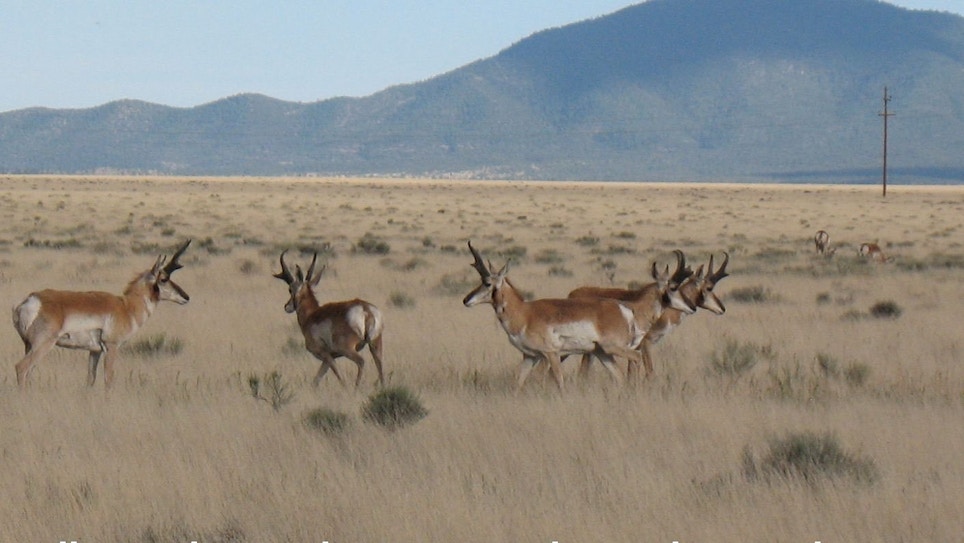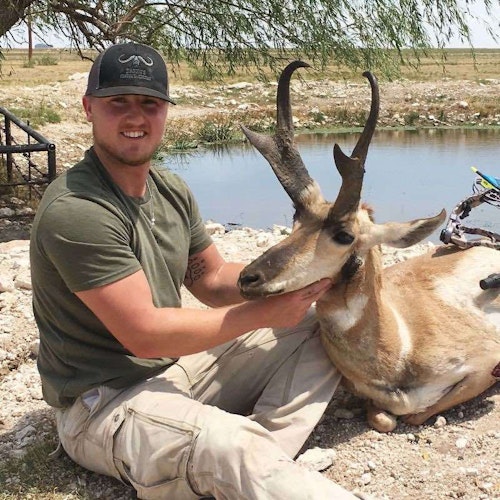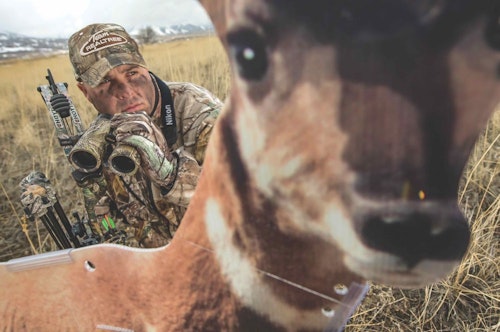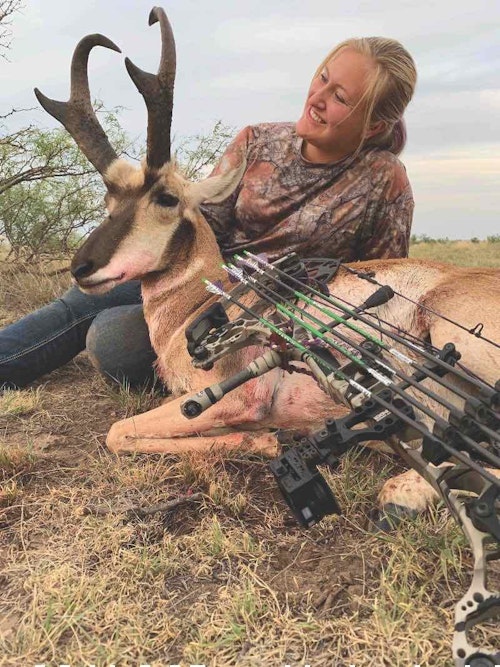Pronghorn, aka antelope, are uniquely American. They’re not really antelope at all, in the same sense of African antelope species, but a stand-alone related only distantly to the chamois of western Europe’s highest mountains. They’re also undeniably gorgeous and unequivocally challenging. This makes them a popular target amongst western bowhunters and a bucket-list species for bowhunters from across North America.
The average bowhunter looking to fill a pronghorn tag will likely need to guard water to find success. This is the most productive mode of operation, particularly when bows and arrows are added to the equation, but by no means the only way to score. The biggest problem with the classic waterhole approach is that late-summer monsoon rains frequently arrive during standard August/September archery-only seasons, quite literally drowning waterhole activities. Not to worry, there are other ways to fill archery pronghorn tags. Let’s look at the most popular ploy, and the alternatives applied when skies turn wooly and rain arrives.
Waterhole 101
Waterhole hunting, like many things in life, appears easy on paper: Find a watering site, toss up a pop-up blind and then wait for the arrival of a trophy buck. Of course, reality proves a bit more involved.
The first step to any successful waterhole venture is patient scouting. Some areas have too many watering options, watering sites impossible to cover with short-range bows, or watering sites that prove less than obvious. Too much water (the problem with rainy weather) is a major hurdle. Yet scouting can reveal a single watering site pronghorn prefer over all others due to reduced livestock traffic, more security or maybe just more palatable water.
Large watering sites are just as problematic, but you’ll often discover pronghorn prefer a particular corner of a large lake or pond due to, again, security, or easier access because of gentler banks. Finally, there are situations when water sources just aren’t conspicuous.
I recall a Moffat County, Colorado, area, for instance, where pronghorns drank from springs flowing from the heads of steep canyons spilling off the edge of a vast mesa. I had to see it for myself to accept the fact that any self-respecting pronghorn would climb into a steep-walled canyon for a drink.
The most straightforward approach to scouting productive pronghorn water is visually inspecting water sources, looking for the sharp, heart-shaped tracks of speed goats at the water’s edge. This can also reveal specific approaches or corners pronghorns prefer for one reason or another.
When confronted by an overabundance of water, a large watering source or especially when targeting a specific buck, I prefer spying on pronghorn from afar and seeing for myself where they drink (and when). This involves hours of sitting and observing, maybe shadowing pronghorn an entire day, peering through top-quality 12- to 15-power binoculars set atop a tripod, or a high-end spotting scope. Rest assured, when it’s hot — namely summer months leading into archery pronghorn seasons — sage goats will drink at least once a day.
The second part of the puzzle is creating concealment within sure archery range and downwind of the place where pronghorn or your targeted buck is likely to drink. Pronghorn don’t depend on their noses to the extent deer do, but mature bucks won’t tolerate a snoot full of human scent either.
The obvious modern-day solution is a portable pop-up blind. They offer a viable option on private lands or remote areas, where they can be placed weeks ahead of the season without the worry of theft or vandalism. To guard against inevitable prairie winds, drive a steel T-post at each corner, wrapping the works in barbed wire to deter itchy or curious cattle.
On well-traveled public lands, pop-ups can prove problematic, in which case a natural blind is in order. I’ve constructed sketchy blinds from gathered branches, brush, tumbleweeds and so on and enjoyed success from them. They might prove mandatory in areas with rocky ground.
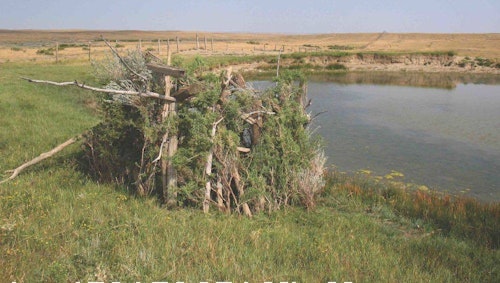
My preferred option (when legal, check regulations in your state) is a carefully-excavated pit blind. A productive pit blind must be deep enough to conceal your form, large enough to comfortably shoot a bow from, and include a comfortable seat sculpted into the rear for the long, sweltering wait. Deep enough means your arrow shelf just clears the front of the pit. Large enough means unrestricted shooting to all likely approaches. It’s back-breaking, sweaty work, made easier with a pickax or heavy digging bar and a sturdy shovel. Once your pit is roughed out — piling excavated soil behind and around the pit proper — natural vegetation from the immediate area is used to camouflage your hide. The goal is a blind that blends seamlessly, not a wholly conspicuous pile of soil and debris.
When a desirable buck (or meat doe for that matter) arrives at water, even when well within range and standing broadside, wait for it to commit before executing your shot. This is especially important when employing minimalist natural blinds, but understand, even from the concealment of a pop-up, pronghorns are notorious string-jumpers. Their renowned eyesight will detect the tiniest movement.
Pronghorn understand they’re vulnerable to predator attack on the water, so are typically jittery. Allow pronghorn to approach water and commit to a drink; there will be several false starts, jerking their heads up several times, attempting to catch a would-be ambusher making a move. Watch their neck muscles. When you see twitching, water moving upward, you usually have a solid 20 to 30 seconds to make your move and execute a perfect shot.

Spot-and-Stalk
The most straightforward ploy when confronted by rainy conditions transforming every low spot into a watering site, an overwatered area or simply arriving on a hunt without the benefit of preseason intel, is spot-and-stalk hunting. Since my old stomping grounds of western New Mexico almost always saw heavy monsoon rains during August archery pronghorn seasons, I’ve actually tagged more pronghorn bucks while stalking than guarding water — including two bucks with recurve bows (one on a rainy Montana foray).
I’ve accomplished this by seeking out terrain that tipped the odds in my favor. You’re obviously not going to crawl up on a hunter-wise buck stalking wide-open, pan-flat habitat. No matter where I’ve bowhunted pronghorn — northwest Colorado, southern Wyoming, eastern Montana, western New Mexico — it was always possible to find an expanse of ground where broken topography, knee-high sage or grass, even scattered cedars, allowed me to patiently slither into bow range. Sometimes this required a half-day wait while a targeted goat moved into favorable terrain or vegetation, but stalking is always all about patience.
You must also be willing to assume undignified positions. Hands-and-knees approaches might be possible with some rimrock, high sage or ground-hugging shrubs involved, but don’t count on it. Pushing your bow ahead a couple feet at a time and belly crawling to it is the more likely outcome. It’s sweaty, time-consuming work, but highly rewarding.
The ability to stretch maximum effective range through smart summertime practice and specialized gear will aid your cause — speedy, lightweight arrows carrying streamlined mechanical broadheads (see sidebar), 7-pin-fixed or mover sights, a steadying 10- to 12-inch stabilizer and more forgiving drop-away rest. Don’t forget knee pads and leather gloves to protect from sharp rocks, hard-baked ground and cactus spines.
Decoying
Decoying pronghorn adds an exciting element to spot-and-stalk ploys and a viable option in wide-open terrain. The basic premise is to stalk within 200 to 300 yards of a pronghorn herd or lone buck, using a terrain fold or rimrock edge, sudden arroyo or vegetation bank as cover before tipping the decoy into place. A sharp snort is issued to grab the buck’s attention; a detuned open-reed call works, or this call can be produced by mouth.
Depending on the season, and hunting pressure, one of three things occurs: the buck or herd turns tail and runs for the horizon, the buck (especially a loner) moves toward you in slow, curious increments, staring more than moving, or a dominant buck charges the decoy, commonly closing the gap to distances better measured in feet than yards. The slow approach is common outside of the rut, and most probable in remote areas or on private lands where pronghorn remain unmolested. I tagged one of my best New Mexico bucks in this manner, an 80-inch bruiser brought from open ground hundreds of yards away and to the edge of cedar cover.
The most effective decoying timeframe is during the September rut, typically taking place mid to late September, depending on latitude. This automatically limits where you will be hunting, as not all pronghorn states offer September archery hunts. Montana, Wyoming and Alberta, Canada, represent hotspots for open rutting dates.
Rut-time decoying is genuinely action-packed, run-and-gun hunting. Success, like any type of game calling/decoying, requires persistence, hitting many herds until discovering a confident and/or aggressive buck willing to confront the decoy. Pronghorn bucks gather doe harems while breeding and will aggressively fend off competing bucks that invade their territorial space — usually 200 to 300 yards. This can be conducted solo, but usually goes most smoothly hunting in pairs, one partner turning the decoy during an approach to keep the shooter covered with the decoy, the shooter remaining on point. Shots typically come together quickly, sometimes involving 5-yard, glancing opportunities. The shooter must stay on top of developments and be able to convert on fleeting shot opportunities.
Guarding Scrapes
It’s common to read about whitetail scrapes, but seldom do you hear of the prospects of bowhunting pronghorn scrapes. More accurately, these could be called pronghorn toilets, but they serve the same purpose. Unlike whitetail scrapes, they are tended year-round as a form of territorial marker. I’ve also observed this behavior with African antelope and certain Texas exotics like blackbuck. The pronghorn scrape is usually an open patch of dirt on a high spot, ranch-road corner/confluence or within a dusty bowl. Pronghorn bucks visit these scrapes periodically, depositing droppings and urine, instead of defecating and urinating where the urge finds them like deer or elk.
Guarding pronghorn scrapes can bring success during any season or weather. However, pronghorn bucks visit scrapes more frequently during wet periods, freshening scent that is washed away by persistent rain. Pronghorn bucks typically maintain many scrapes at the edges of their perceived territories. Still, there will generally be one site that receives more attention than all the others — the primary scrape, if you will.
Finding these scrapes involves a lot of snooping, usually by keeping an eye peeled when in pronghorn country (you might even develop an eye for preferred scraping sites if you spend enough time in specific habitats). But I’ve enjoyed better luck by investing in long-range reconnaissance, shadowing specific bucks remotely through high-power, tripod-mounted optics and noting where bucks squat to do their business. Finding the most productive primary scrapes might require several weekends of spying, but it’s time well spent if putting an arrow through a particular trophy buck is your goal.
Concealment approaches remain the same as waterhole hides. However, I’ve always been hesitant to go the pop-up route (though hard, rocky ground might demand it) for fear of putting a wary buck off. A less-apparent natural blind, especially a ground-flush pit, seems to raise fewer suspicions.
Pronghorn offer unique bowhunting challenges and are worthy adversaries. Waterhole hunting will always prove the most sensible and productive approach, but don’t be afraid to approach things from a different angle, especially when rains arrive to ruin waterhole prospects, or when targeting a specific buck under challenging conditions. There’s more than one way to skin a pronghorn, and more than one way to enjoy these uniquely American big game animals!
Sidebar: Hot-Weather Pronghorn Blinds
Late-summer pronghorn hunts can get downright hot, especially inside an enclosed pop-up blind. Here are two models that will keep you under cover without cooking you during long waits.
Rhino Blinds: The Bone Collector R-150 in Realtree Edge comfortably accommodates two to three hunters in a five-hub system that’s easy setup and holds up to high winds. It includes brush loops for adding camouflage. It comes with a backpack-style carrying bag for easy transport into remote sites.
Primos: The 20-pound Smokescreen Ground Blind utilizes one-way see-through technology allowing hunters to see out while preventing game from seeing in while also allowing a certain degree of airflow. It includes seven shoot-through ports and three max-viewing windows to provide a 270-degree view of your surroundings. The blind can hold up to three people, accessed through a triangular door. A 300D brushed polyester shell (covered in effective Ground Swat Camo) and aluminum hubs allow it to stand up to high winds.
Sidebar: Pronghorn Terminal Gear
When it comes to pronghorn arrows, I want maximum speed to flatten trajectories and provide more latitude for small range-judging errors, without sacrificing durability. Additionally, I want mechanical broadhead designs (where legal) that are streamlined in flight for pinpoint shot placement at long distances. Still, wide-cutting blades to turn marginal hits into killing shots could make my shot fall slightly off the mark.
A trio of my favorite combinations are listed below.
Easton Matrix 6.5 and New Archery Products Spitfire Maxx
Why? Easton Archery’s new standard-diameter Matrix 6.5 with ACU-Carbon construction is tough and includes .003-inch straightness tolerances. They weigh 8.1 gpi in 340 spine and hold lighter Microlite nocks. NAP’s proven 100-grain Spitfire Maxx cuts 1.75-inches wide but lays flat in flight for excellent accuracy. It includes a cutting tip and patented blade-retention system sans rubber bands or O-rings.
Gold Tip Airstrike and Rocket Broadheads Siphon XB
Why? Gold Tip’s .204-inch diameter Airstrike defies crosswinds and drives deep. They are also GT tough, including quiet-draw Dyna-Tek Slick Shield coating and Nock and Ballistic collars. They include unsurpassed .001-inch straightness tolerances and weigh 7.8 gpi in 340-spine for maximum speed. Rocket’s aerodynamic three-blade Siphon XB cuts a devastating 1.75-inch swath lead by a bone-splitting cutting-edge tip.
Carbon Express Maxima XRZ Select and Rage Hypodermic Trypan NC
This combo is my favorite. Why? CX’s .244-inch diameter Maxima XRZ Select includes Tri-Spine/RED ZONE technology, Backbone 360-degree spine consistency and .001-inch straightness tolerances for extreme precision. Bulldog Nock Collars protect shaft ends, with Launchpad Nocks further boosting accuracy. They weigh 8.4 gpi in 350-spine. Rage’s 100-grain, titanium-ferruled Hypodermic Trypan NC (No Collar) cuts nasty 2-inch wound channels with two super-sharp blades.
